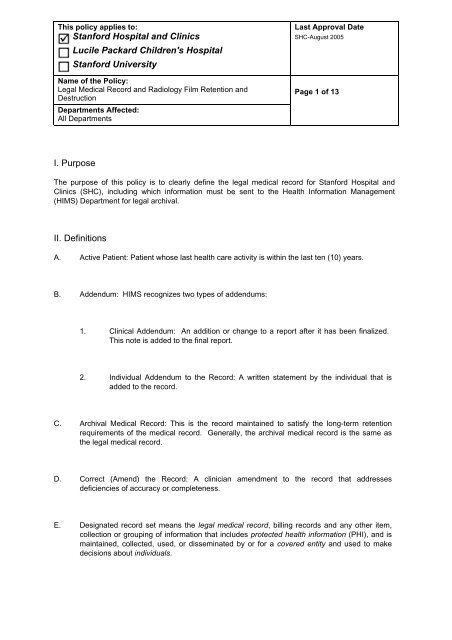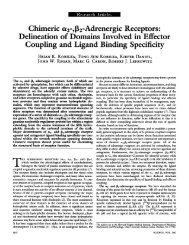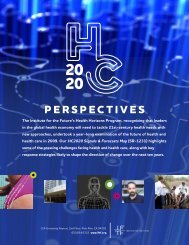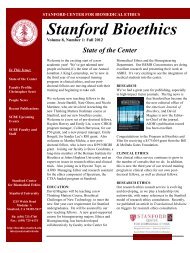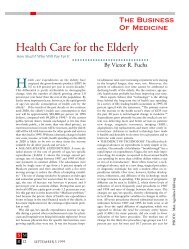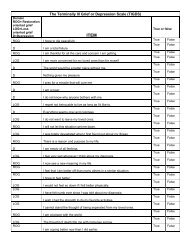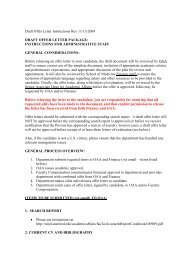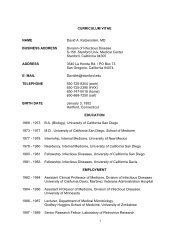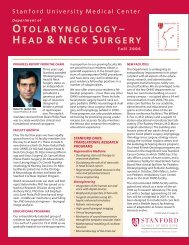SHC Policy-Legal Medical Records and Radiology Film Retention ...
SHC Policy-Legal Medical Records and Radiology Film Retention ...
SHC Policy-Legal Medical Records and Radiology Film Retention ...
You also want an ePaper? Increase the reach of your titles
YUMPU automatically turns print PDFs into web optimized ePapers that Google loves.
This policy applies to:<br />
Stanford Hospital <strong>and</strong> Clinics<br />
Lucile Packard Children's Hospital<br />
Stanford University<br />
Name of the <strong>Policy</strong>:<br />
<strong>Legal</strong> <strong>Medical</strong> Record <strong>and</strong> <strong>Radiology</strong> <strong>Film</strong> <strong>Retention</strong> <strong>and</strong><br />
Destruction<br />
Departments Affected:<br />
All Departments<br />
I. Purpose<br />
The purpose of this policy is to clearly define the legal medical record for Stanford Hospital <strong>and</strong><br />
Clinics (<strong>SHC</strong>), including which information must be sent to the Health Information Management<br />
(HIMS) Department for legal archival.<br />
II. Definitions<br />
A. Active Patient: Patient whose last health care activity is within the last ten (10) years.<br />
B. Addendum: HIMS recognizes two types of addendums:<br />
Last Approval Date<br />
<strong>SHC</strong>-August 2005<br />
Page 1 of 13<br />
1. Clinical Addendum: An addition or change to a report after it has been finalized.<br />
This note is added to the final report.<br />
2. Individual Addendum to the Record: A written statement by the individual that is<br />
added to the record.<br />
C. Archival <strong>Medical</strong> Record: This is the record maintained to satisfy the long-term retention<br />
requirements of the medical record. Generally, the archival medical record is the same as<br />
the legal medical record.<br />
D. Correct (Amend) the Record: A clinician amendment to the record that addresses<br />
deficiencies of accuracy or completeness.<br />
E. Designated record set means the legal medical record, billing records <strong>and</strong> any other item,<br />
collection or grouping of information that includes protected health information (PHI), <strong>and</strong> is<br />
maintained, collected, used, or disseminated by or for a covered entity <strong>and</strong> used to make<br />
decisions about individuals.
This policy applies to:<br />
Stanford Hospital <strong>and</strong> Clinics<br />
Lucile Packard Children's Hospital<br />
Stanford University<br />
Name of the <strong>Policy</strong>:<br />
<strong>Legal</strong> <strong>Medical</strong> Record <strong>and</strong> <strong>Radiology</strong> <strong>Film</strong> <strong>Retention</strong> <strong>and</strong><br />
Destruction<br />
Departments Affected:<br />
All Departments<br />
Last Approval Date<br />
<strong>SHC</strong>-August 2005<br />
Page 2 of 13<br />
F. Final Authenticated Report: The medical record report which has been verified <strong>and</strong><br />
authenticated, often by signing, as being correct.<br />
G. Interfaced Documents: Electronic transfer of clinical reports from ancillary systems to the<br />
document imaging system through an FTP or an HL7 interface.<br />
H. <strong>Legal</strong> <strong>Medical</strong> Record: The official medical record compiling all notes <strong>and</strong> authenticated<br />
documents concerning a patient’s care. This is the record provided for follow-up care <strong>and</strong> in<br />
response to billing, audits, quality assurance, legal requests or research requests when<br />
appropriate authorization is provided.<br />
I. Paper Chart: Refers to the paper based medical record, containing all original clinical<br />
information for a patient generated prior to January 29, 1997.<br />
J. <strong>Radiology</strong> <strong>Film</strong> <strong>Records</strong>: The <strong>Radiology</strong> exam records refer to exams obtained for diagnostic<br />
purposes. In their original form they can be archived on film, disc or electronic archive.<br />
K. Scanned <strong>Records</strong>: Paper documents captured as images <strong>and</strong> stored in an electronic<br />
computerized format called TIFF. All medical records generated on <strong>and</strong> after January 29,<br />
1997 are scanned <strong>and</strong> stored as TIFF images.<br />
L. Shadow Charts: Copies of medical record documentation stored locally within the clinical<br />
areas. Originals are stored by HIMS.<br />
M. Source Data: All original information or data or certified copies of such original information<br />
contained in source documents.
This policy applies to:<br />
Stanford Hospital <strong>and</strong> Clinics<br />
Lucile Packard Children's Hospital<br />
Stanford University<br />
Name of the <strong>Policy</strong>:<br />
<strong>Legal</strong> <strong>Medical</strong> Record <strong>and</strong> <strong>Radiology</strong> <strong>Film</strong> <strong>Retention</strong> <strong>and</strong><br />
Destruction<br />
Departments Affected:<br />
All Departments<br />
N. Source Document: Documents in the medical record, which are either the original document<br />
or copies or transcriptions certified after verification as being an exact replication of the<br />
original document. When original observations are directly entered into a computer system,<br />
the electronic record is the source document.<br />
O. TIFF (Tagged Image File Format): An industry st<strong>and</strong>ard file format for bitmapped images<br />
often used to exchange such files between dissimilar computers <strong>and</strong> by scanners when<br />
converting pictures to computer form. The name comes from the specification that describes<br />
how to store information in blocks called tags. The format accurately depicts the image of<br />
scanned paper <strong>and</strong> is designed to store a complete image of an original paper document.<br />
III. <strong>Policy</strong> Statement<br />
Health Information Management Systems (HIMS) maintains the legal <strong>and</strong> archival medical records<br />
for Stanford Hospital <strong>and</strong> Clinics (<strong>SHC</strong>). The legal medical record contains all final, authenticated<br />
reports <strong>and</strong> is used for patient care, legal, research, audit, <strong>and</strong> billing purposes. It is the<br />
responsibility of each clinical unit to ensure that all clinical documentation is received by or interfaced<br />
to HIMS within 24 hours after the documentation is generated.<br />
The <strong>SHC</strong> legal record is archived differently depending on the period of patient care:<br />
A.Patient documentation generated on <strong>and</strong> after January 29, 1997<br />
The legal archival record is the electronic medical record, which is scanned or interfaced,<br />
<strong>and</strong> is stored as TIFF image or text.<br />
B.Patient documentation generated prior to January 29, 1997<br />
Last Approval Date<br />
<strong>SHC</strong>-August 2005<br />
Page 3 of 13<br />
The legal, archival record is the paper chart stored in an off-site storage facility.
This policy applies to:<br />
Stanford Hospital <strong>and</strong> Clinics<br />
Lucile Packard Children's Hospital<br />
Stanford University<br />
Name of the <strong>Policy</strong>:<br />
<strong>Legal</strong> <strong>Medical</strong> Record <strong>and</strong> <strong>Radiology</strong> <strong>Film</strong> <strong>Retention</strong> <strong>and</strong><br />
Destruction<br />
Departments Affected:<br />
All Departments<br />
IV. Principles<br />
It is the policy of <strong>SHC</strong> that patients’ legal medical records <strong>and</strong> radiology film records be<br />
preserved safely. Adult patient <strong>and</strong> emancipated minor medical records shall be preserved<br />
for a minimum of ten (10) years from the last date of patient care activity. The medical<br />
records <strong>and</strong> radiology film records of unemancipated minors shall be retained for at least<br />
one year after such minor has reached the age of eighteen (18), but in no case for less<br />
than ten (10) years following discharge.<br />
A. <strong>Medical</strong> records shall be maintained to document any treatment decisions about individuals.<br />
B. <strong>Medical</strong> records shall be made available for follow-up care <strong>and</strong> in response to billing, audits,<br />
quality assurance, legal requests, or research requests when appropriate authorization is<br />
provided.<br />
C. Appropriate safeguards shall be implemented to protect the security <strong>and</strong> confidentiality of all<br />
medical records.<br />
D. <strong>Medical</strong> records <strong>and</strong> radiology films must be retained in accordance with state guidelines <strong>and</strong><br />
may only be destroyed with the concurrence of the <strong>Medical</strong> Board <strong>and</strong> hospital<br />
administration.<br />
E. Procedures shall be implemented to insure the integrity of the medical records<br />
F. Electronic medical records shall be backed-up using existing available technology.<br />
V. Procedures<br />
Last Approval Date<br />
<strong>SHC</strong>-August 2005<br />
Page 4 of 13<br />
A. <strong>Medical</strong> records shall be maintained to document any treatment decisions about<br />
individuals.
This policy applies to:<br />
Stanford Hospital <strong>and</strong> Clinics<br />
Lucile Packard Children's Hospital<br />
Stanford University<br />
Name of the <strong>Policy</strong>:<br />
<strong>Legal</strong> <strong>Medical</strong> Record <strong>and</strong> <strong>Radiology</strong> <strong>Film</strong> <strong>Retention</strong> <strong>and</strong><br />
Destruction<br />
Departments Affected:<br />
All Departments<br />
Last Approval Date<br />
<strong>SHC</strong>-August 2005<br />
Page 5 of 13<br />
1. All archived paper records prior to January 29, 1997 are kept in an off-site storage<br />
facility <strong>and</strong> are retrieved when needed for patient care, legal requests, audit, billing,<br />
research requests when appropriate authorization is provided, <strong>and</strong> other purposes.<br />
The off-site storage facilities meet all state <strong>and</strong> federal requirements for<br />
confidentiality, security <strong>and</strong> integrity of medical record storage. Appropriate<br />
applications to the state will be made to open a new storage facility. Access<br />
policies <strong>and</strong> procedures are addressed in the policy titled: “HIPAA Internal Access<br />
to Protected Health Information <strong>Policy</strong>”.<br />
2. There are two ways medical records are entered into the electronic record:<br />
a. Scanning: Documents are scanned <strong>and</strong> are stored electronically as<br />
magnetic or optical TIFF images. Scanned electronic images are<br />
unalterable, verified to be an exact replication of the original document<br />
<strong>and</strong> are the source document. After scanning, the original paper records<br />
are stored off-site temporarily until quality checks are done, then they are<br />
destroyed.<br />
b. Direct Entry: Electronic reports generated by ancillary system are<br />
interfaced directly into the document imaging system <strong>and</strong> are indexed as<br />
text documents. These documents are also unalterable, verified to be an<br />
exact replication of the original document <strong>and</strong> are the source document.<br />
3. <strong>SHC</strong> maintains a centralized medical record managed by the HIMS Department.<br />
Some Stanford Clinics maintain shadow file systems. These files are only<br />
authorized to hold duplicate copies of notes <strong>and</strong> reports. The shadow files should<br />
not contain original or top copy documents.<br />
4. Due to geographic locations, there are sites whose medical records are maintained<br />
locally such as Vaden Student Health Center. The <strong>SHC</strong> HIMS Department provides<br />
medical record oversight over these clinics.
This policy applies to:<br />
Stanford Hospital <strong>and</strong> Clinics<br />
Lucile Packard Children's Hospital<br />
Stanford University<br />
Name of the <strong>Policy</strong>:<br />
<strong>Legal</strong> <strong>Medical</strong> Record <strong>and</strong> <strong>Radiology</strong> <strong>Film</strong> <strong>Retention</strong> <strong>and</strong><br />
Destruction<br />
Departments Affected:<br />
All Departments<br />
B. <strong>Medical</strong> records shall be made available for follow-up care <strong>and</strong> in response to billing, audits,<br />
quality assurance, legal requests, or research requests when appropriate authorization is<br />
provided.<br />
1. Scanned records <strong>and</strong> interfaced reports can be accessed by authorized staff using<br />
MedRec (web-based viewer) through the hospital Intranet. Upon request <strong>and</strong><br />
validation of need to know, the HIMS Department can print appropriate sections of<br />
the medical records.<br />
2. Archived paper records prior to January 29, 1997 can be retrieved from off-site<br />
storage when requested.<br />
C. Appropriate safeguards shall be implemented to protect the security <strong>and</strong> confidentiality of all<br />
medical records.<br />
1. <strong>SHC</strong> has procedures to protect the confidentiality <strong>and</strong> security of patient<br />
information. These are set forth in a series of policies, including the following:<br />
• Confidentiality Principles Regarding Patient Information<br />
• User ID <strong>and</strong> Password<br />
• HIPAA Internal Access to Protected Health Information <strong>Policy</strong><br />
• Workstation <strong>and</strong> Application Timeout<br />
• Off Campus Access to Electronically Stored Patient Data<br />
• Audit of Access to Electronic Patient Information<br />
Last Approval Date<br />
<strong>SHC</strong>-August 2005<br />
Page 6 of 13<br />
2. <strong>SHC</strong> has implemented security measures <strong>and</strong> software safeguards to prevent<br />
unauthorized access to the paper records <strong>and</strong> computerized systems.
This policy applies to:<br />
Stanford Hospital <strong>and</strong> Clinics<br />
Lucile Packard Children's Hospital<br />
Stanford University<br />
Name of the <strong>Policy</strong>:<br />
<strong>Legal</strong> <strong>Medical</strong> Record <strong>and</strong> <strong>Radiology</strong> <strong>Film</strong> <strong>Retention</strong> <strong>and</strong><br />
Destruction<br />
Departments Affected:<br />
All Departments<br />
Last Approval Date<br />
<strong>SHC</strong>-August 2005<br />
Page 7 of 13<br />
a. Paper medical record files shall be stored in an area that limits access to<br />
authorized personnel only. <strong>Records</strong> in use shall be located in an area<br />
secure from public access.<br />
b. User IDs <strong>and</strong> passwords protect information systems that contain<br />
electronic medical record information. Managers determine which staff<br />
needs access <strong>and</strong> approve requests for those employees (based on<br />
minimum necessary requirements for their role). The IT Access Control<br />
Unit controls the issuing <strong>and</strong> termination of UserID’s <strong>and</strong> passwords.<br />
Passwords expire on a scheduled basis. Computer screens are<br />
designed to time-out when not active for a specified time. Sharing<br />
passwords is a cause for disciplinary action, including termination of<br />
employment.<br />
D. <strong>Medical</strong> records <strong>and</strong> radiology films must be retained in accordance with state guidelines<br />
<strong>and</strong> may only be destroyed with the concurrence of the <strong>Medical</strong> Board <strong>and</strong> hospital<br />
administration.<br />
1. It is the policy of <strong>SHC</strong> that a patient’s legal medical records are preserved safely.<br />
a. Adult patient <strong>and</strong> emancipated minor records shall be preserved for a<br />
minimum of ten (10) years from the last date of patient care activity.<br />
b. The records of unemancipated minors shall be retained for at least one<br />
year after such minor has reached the age of eighteen (18), but in no<br />
case less than ten (10) years following discharge.<br />
2. The California Healthcare Association’s “Record <strong>Retention</strong> Guide” serves as the<br />
resource on retention of records.
This policy applies to:<br />
Stanford Hospital <strong>and</strong> Clinics<br />
Lucile Packard Children's Hospital<br />
Stanford University<br />
Name of the <strong>Policy</strong>:<br />
<strong>Legal</strong> <strong>Medical</strong> Record <strong>and</strong> <strong>Radiology</strong> <strong>Film</strong> <strong>Retention</strong> <strong>and</strong><br />
Destruction<br />
Departments Affected:<br />
All Departments<br />
3. <strong>Retention</strong> of original records that have been scanned.<br />
a. These are the original copies of the scanned records. The TIFF images,<br />
which are exact representation of these paper documents, become the<br />
legal record.<br />
b. After scanning, the original paper records are stored temporarily offsite<br />
until quality checks are done, then they qualify for destruction.<br />
4. <strong>Retention</strong> of Shadow <strong>Medical</strong> <strong>Records</strong><br />
The shadow records are not the legal records <strong>and</strong> are used by clinic physicians <strong>and</strong><br />
other outpatient areas for their convenience. It is the responsibility of each clinical<br />
area to ensure that all source documents are delivered to the HIMS department for<br />
archiving.<br />
5. Destruction of <strong>Medical</strong> <strong>Records</strong> <strong>and</strong> <strong>Radiology</strong> <strong>Film</strong><br />
Last Approval Date<br />
<strong>SHC</strong>-August 2005<br />
Page 8 of 13<br />
a. The legal medical records <strong>and</strong> radiology film qualify for destruction when<br />
patients are inactive for more than ten (10) years. <strong>Records</strong> qualify for<br />
destruction when they exceed the criteria as defined in paragraph D 1<br />
above.<br />
b. The Director of HIMS (<strong>Medical</strong> <strong>Records</strong>) may authorize destruction of the<br />
legal medical after consultation <strong>and</strong> approval of Hospital Administration<br />
<strong>and</strong> the <strong>Medical</strong> Board. The Director of <strong>Radiology</strong> may authorize the<br />
retention or destruction of the original radiology films or the electronically<br />
archived images after consultation <strong>and</strong> approval of Hospital<br />
Administration <strong>and</strong> <strong>Medical</strong> Board.
This policy applies to:<br />
Stanford Hospital <strong>and</strong> Clinics<br />
Lucile Packard Children's Hospital<br />
Stanford University<br />
Name of the <strong>Policy</strong>:<br />
<strong>Legal</strong> <strong>Medical</strong> Record <strong>and</strong> <strong>Radiology</strong> <strong>Film</strong> <strong>Retention</strong> <strong>and</strong><br />
Destruction<br />
Departments Affected:<br />
All Departments<br />
c. Since the HIMS Department maintains the legal record, the shadow<br />
records may be destroyed at the convenience of the clinic or when<br />
deemed necessary due to space constraints <strong>and</strong> patient inactivity. The<br />
responsible Vice President may authorize destruction of this patient<br />
information after ensuring that all original documentation has been<br />
delivered to HIMS.<br />
d. The hospital has several options for destroying inactive, paper records.<br />
The procedure is the same for destroying legal medical records, shadow<br />
charts or other ancillary information:<br />
1. Contract with an outside vendor to shred or burn paper records.<br />
If this option is used, the vendor is required to provide a<br />
Certificate of Destruction when the work is completed. The<br />
management group authorizing the destruction should keep this<br />
record.<br />
2. Destroy paper records in-house<br />
Last Approval Date<br />
<strong>SHC</strong>-August 2005<br />
Page 9 of 13<br />
e. Destruction of inactive imaging records occurs when the criteria for film<br />
disposal have been met. The <strong>Radiology</strong> Imaging Manager will contact a<br />
vendor who is licensed to dispose of hazardous materials (re: films<br />
containing silver) according to State <strong>and</strong> Federal Regulations.<br />
E. Procedures shall be implemented to insure the integrity of the medical records. (See the<br />
<strong>SHC</strong> policy “Document Scanning Verification Process”)<br />
1. The paper medical records stored off-site are tracked using an electronic chart<br />
locator application. <strong>Records</strong> stored within the off-site storage facility are also<br />
tracked using their own chart locator system.
This policy applies to:<br />
Stanford Hospital <strong>and</strong> Clinics<br />
Lucile Packard Children's Hospital<br />
Stanford University<br />
Name of the <strong>Policy</strong>:<br />
<strong>Legal</strong> <strong>Medical</strong> Record <strong>and</strong> <strong>Radiology</strong> <strong>Film</strong> <strong>Retention</strong> <strong>and</strong><br />
Destruction<br />
Departments Affected:<br />
All Departments<br />
2. It is the responsibility of each clinical unit to ensure that all clinical documentation is<br />
delivered or interfaced to HIMS within 24 hours after the documentation is<br />
generated. HIMS tracks receipt of Inpatient, Emergency, <strong>and</strong> Outpatient Surgery<br />
records. Discharge records not received or partially missing records are tracked in<br />
a database <strong>and</strong> are followed-up on a daily basis by the HIMS Discharge Control<br />
Team.<br />
3. The document imaging process is subject to specific verification <strong>and</strong> quality controls<br />
requirements (see the <strong>SHC</strong> “Document Scanning Verification Process” policy).<br />
F. Electronic medical records shall be backed-up using existing available technology.<br />
The <strong>SHC</strong> electronic medical record (EMR) is maintained on a RAID 5 Storage Area Network<br />
(SAN) <strong>and</strong> is backed up daily.<br />
VI. Related Documents or Policies<br />
A. <strong>Medical</strong> Record Documentation <strong>Policy</strong><br />
B. Document Scanning Verification Process<br />
C. HIPAA Internal Access to Protected Health Information <strong>Policy</strong><br />
D. HIPAA Correction (Amendment) of Protected Health Information <strong>and</strong> Addendum <strong>Policy</strong><br />
E. HIPAA Designated Record Set <strong>Policy</strong><br />
F. HIPAA “Minimum Necessary” Use <strong>and</strong> Disclosure of, <strong>and</strong> Requests for, Protected Health<br />
Information<br />
G. Audit of Access to Electronic Patient Information<br />
H. Confidentiality Principles Regarding Patient Information<br />
I. User ID <strong>and</strong> Password (sunsetted 2004)<br />
J. Workstation <strong>and</strong> Application Timeout (sunsetted 2004)<br />
Last Approval Date<br />
<strong>SHC</strong>-August 2005<br />
Page 10 of 13
This policy applies to:<br />
Stanford Hospital <strong>and</strong> Clinics<br />
Lucile Packard Children's Hospital<br />
Stanford University<br />
Name of the <strong>Policy</strong>:<br />
<strong>Legal</strong> <strong>Medical</strong> Record <strong>and</strong> <strong>Radiology</strong> <strong>Film</strong> <strong>Retention</strong> <strong>and</strong><br />
Destruction<br />
Departments Affected:<br />
All Departments<br />
VII. Document Information<br />
A. <strong>Legal</strong> Authority/References<br />
1. Title 22: California Code of Regulations<br />
2. Joint Commission on Accreditation of Hospitals (JCAHO): IM St<strong>and</strong>ard<br />
3. Health Care Financing Administration<br />
4. Code of Federal Register: 21 CFR Part 11 <strong>and</strong> FDA Guidelines on Electronic<br />
<strong>Records</strong><br />
5. Federal Register, Vol. 65, No. 250, December 28, 2000, pages<br />
82798 to 82829<br />
6. Federal Register, Vol. 67, No. 157, August 14, 2002, pages 53181 to 53273<br />
7. California Healthcare Association: Record <strong>Retention</strong> Guide<br />
B. Author/Original Date<br />
February 2001, D. Myjer, PhD, Director of HIMS, <strong>and</strong> R. Madamba, RHIA, Manager of<br />
Record Archiving<br />
C. Gatekeeper of Original Document<br />
Administrative Manual Coordinators <strong>and</strong> Editors<br />
D. Distribution <strong>and</strong> Training Requirements<br />
Last Approval Date<br />
<strong>SHC</strong>-August 2005<br />
Page 11 of 13<br />
1. This policy resides in the Administrative Manual of Stanford Hospital <strong>and</strong> Clinics.<br />
2. New documents or any revised documents will be distributed to Administrative
This policy applies to:<br />
Stanford Hospital <strong>and</strong> Clinics<br />
Lucile Packard Children's Hospital<br />
Stanford University<br />
Name of the <strong>Policy</strong>:<br />
<strong>Legal</strong> <strong>Medical</strong> Record <strong>and</strong> <strong>Radiology</strong> <strong>Film</strong> <strong>Retention</strong> <strong>and</strong><br />
Destruction<br />
Departments Affected:<br />
All Departments<br />
Manual holders. The department/unit/clinic manager will be responsible for<br />
communicating this information to the applicable staff.<br />
E. Review <strong>and</strong> Renewal Requirements<br />
This policy will be reviewed <strong>and</strong>/or revised every three years or as required by change of law<br />
or practice.<br />
F. Review <strong>and</strong> Revision History<br />
September 2003, revised D. Myjer, PhD, Director of HIMS, <strong>and</strong> R. Madamba, RHIA, Manager<br />
of Record Archiving<br />
G. Approvals<br />
February 2001, HIMS Management<br />
February 2001, <strong>SHC</strong> HIM Committee<br />
June 2001, <strong>Legal</strong> Review by Ropes <strong>and</strong> Gray<br />
August 2001, <strong>SHC</strong> <strong>Medical</strong> Board<br />
August 2001, <strong>SHC</strong> Hospital Board<br />
April 2003, LPCH <strong>Medical</strong> Board<br />
April 2003, LPCH Board of Directors<br />
September 2003, HIMS Management<br />
Date Pending, <strong>SHC</strong> HIM Committee<br />
March 2004, Quality Improvement Patient Safety Committee<br />
Date Pending, <strong>Legal</strong> Review by Ropes <strong>and</strong> Gray<br />
August 2005, <strong>SHC</strong> <strong>Medical</strong> Board<br />
Last Approval Date<br />
<strong>SHC</strong>-August 2005<br />
Page 12 of 13
This policy applies to:<br />
Stanford Hospital <strong>and</strong> Clinics<br />
Lucile Packard Children's Hospital<br />
Stanford University<br />
Name of the <strong>Policy</strong>:<br />
<strong>Legal</strong> <strong>Medical</strong> Record <strong>and</strong> <strong>Radiology</strong> <strong>Film</strong> <strong>Retention</strong> <strong>and</strong><br />
Destruction<br />
Departments Affected:<br />
All Departments<br />
August 2005, <strong>SHC</strong> Hospital Board<br />
This document is intended for use by staff of Stanford Hospital & Clinics <strong>and</strong>/or Lucile Packard Children's Hospital.<br />
No representations or warranties are made for outside use.<br />
Not for outside reproduction or publication without permission.<br />
Last Approval Date<br />
<strong>SHC</strong>-August 2005<br />
Page 13 of 13


